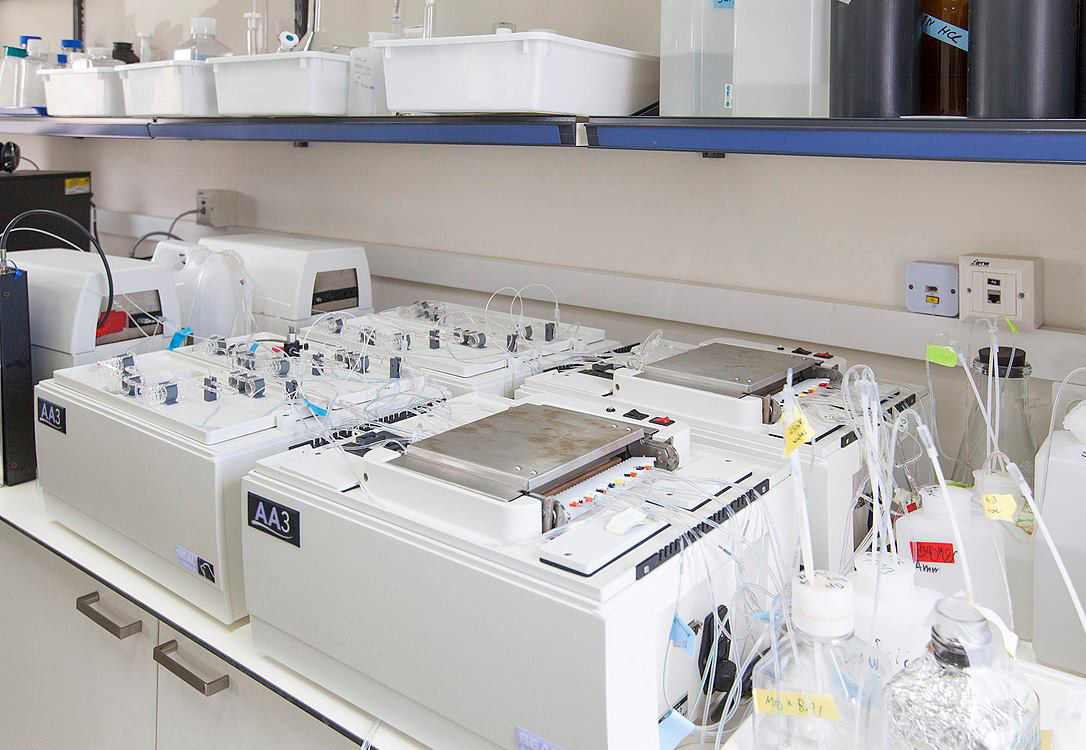 Researchers at Haifa University’s Marine Biological Station in Israel are exploiting the ultra-low detection limits of advanced laboratory equipment to measure extremely low nutrient concentrations in marine water. The University’s Prof. Krom says: "We work in the Eastern Mediterranean which has the lowest regional concentration of dissolved nutrients anywhere in the global ocean. We therefore utilize an automated segmented flow analyzer from SEAL Analytical, which has been specially adapted to accommodate ultra-low measurements.”
Researchers at Haifa University’s Marine Biological Station in Israel are exploiting the ultra-low detection limits of advanced laboratory equipment to measure extremely low nutrient concentrations in marine water. The University’s Prof. Krom says: "We work in the Eastern Mediterranean which has the lowest regional concentration of dissolved nutrients anywhere in the global ocean. We therefore utilize an automated segmented flow analyzer from SEAL Analytical, which has been specially adapted to accommodate ultra-low measurements.”
The SEAL AutoAnalyzer 3 (AA3) is a 4 channel system, measuring Phosphate with a long flow cell which has a detection limit of 2 nM. Ammonia is measured using a JASCO fluorometer with a similar ultra-low detection limit, and Silicate, which has a higher concentration, is measured using SEAL’s high resolution colorimetric technology.
The measurement data are being used to determine the season nutrient cycling in the system, which will then be used to help understand the nature of the food web and the effects of global environmental and climate change.
Low nutrient levels in the Mediterranean
The eastern Mediterranean Sea (EMS) has an almost unique water circulation. The surface waters (0-200m) flow into the Mediterranean through the Straits of Gibraltar and from there into the EMS at the Straits of Sicily. As the water flows towards the east it becomes increasingly saline and hence denser. When it reaches the coast of Turkey in winter it also cools and then flows back out of the Mediterranean under the surface waters to Sicily, and then eventually through the Straits of Gibraltar to the North Atlantic. This outflowing layer exists between 200m and 500m depth.
Phytoplankton grow in the surface waters (0-200m) because that is the only layer with sufficient light. This layer receives nutrients from the adjacent land, from rivers and wastewater discharges, and also from aerosols in the atmosphere. These nutrients are utilized by the plankton as they photosynthesize. When the plants die (or are eaten) their remains drop into the lower layer and are jetted out of the EMS. Because the water flows are so fast (it takes just 8 years for the entire surface layers of the EMS to be replaced), these nutrient rich intermediate waters rapidly expel nutrients from the basin. The result is very low nutrient concentrations and very low numbers of phytoplankton – some of the lowest values anywhere in the world. Prof. Krom says: “The maximum levels of nutrients measured in the EMS are 250 nM phosphate, 6 uM nitrate and 6-12 uM silicate. Ammonia is often in the low nanomolar range. By contrast, in the North Atlantic, values are 1000 nM phosphate, 16 uM nitrate and 20 uM silicate, and the levels in the North Pacific are even higher.”
The value of data
The low levels of plankton caused by low nutrient levels, result in a low biomass of fish. Nevertheless, coastal areas generally support more fish than offshore, so the research will seek to quantify and understand the nutrient cycle in the coastal regions, which is poorly understood at present. Prof. Krom says: “We plan to develop understandings which will inform stakeholders such as government. For example, there is a discussion about the potential for fish farms off the Israeli coast, so our work will enable science-based decisions regarding the quantity of fish that the system can support.”
To-date, three data sets have been taken from the EMS, and the first publishable paper is in the process of being prepared.
Choosing the right analyzer
Prof. Krom says that his first ‘real’ job was working for the (then) Water Research Centre at Medmenham in the UK, where he was involved in the development of chemical applications for the Technicon AA-II autoanalyzers, which included going on secondment to Technicon for several months. SEAL Analytical now own and manufacture the AutoAnalyzer brand of Continuous Segmented Flow Analyzers, so Prof. Krom’s career has been connected with autoanalyzers for decades. For example, Prof. Krom is Professor (Emeritus) at the University of Leeds in the UK, where, again, he worked with SEAL autanalyzers. An AA3 instrument was employed at Leeds in a project to investigate the nature of atmospheric acid processing of mineral dusts in supplying bioavailable phosphorus to the oceans.
Explaining the reasoning behind the purchase of a new AA3 at Haifa University, Prof. Krom says: “During a research cruise, it is necessary to analyse samples within a day to avoid changes in concentration due to preservation procedures.
“Typically we analyse 50-80 samples per day, so it is useful to useful to be able to analyze large numbers of samples automatically. However, the main reasons for choosing the SEAL AA3 were the precision, accuracy and low limits of detection that it provides.”
Commenting on this application for SEAL’s analyzers, company President Stuart Smith says: “Many of our customers analyze nutrient levels in freshwater and marine water samples, where high levels of nutrients are a concern because of increasing levels of algal blooms and eutrophication. However, Prof. Krom’s work is very interesting because, in contrast, he is looking at extremely low levels, so it is very gratifying that our instruments are able to operate at both ends of the nutrient concentration spectrum.”